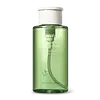What's inside
What's inside
 Key Ingredients
Key Ingredients

 Benefits
Benefits

 Concerns
Concerns

 Ingredients Side-by-side
Ingredients Side-by-side

Water
Skin ConditioningPEG-6 Caprylic/Capric Glycerides
EmulsifyingRosa Damascena Flower
Skin ConditioningHibiscus Sabdariffa Flower
Skin ConditioningRosa Damascena Extract
MaskingAloe Barbadensis Leaf Extract
EmollientRosmarinus Officinalis Flower Extract
AntioxidantBrassica Oleracea Italica Extract
AstringentSymphytum Officinale Leaf Extract
Skin ConditioningHyaluronic Acid
HumectantCucumis Sativus Fruit Extract
EmollientCentella Asiatica Extract
Cleansing1,2-Hexanediol
Skin ConditioningPhenoxyethanol
PreservativeEthylhexylglycerin
Skin ConditioningDipropylene Glycol
HumectantXylitol
HumectantCetrimonium Chloride
AntimicrobialSodium Chloride
MaskingPanthenol
Skin ConditioningPEG-60 Hydrogenated Castor Oil
EmulsifyingDisodium EDTA
Parfum
MaskingWater, PEG-6 Caprylic/Capric Glycerides, Rosa Damascena Flower, Hibiscus Sabdariffa Flower, Rosa Damascena Extract, Aloe Barbadensis Leaf Extract, Rosmarinus Officinalis Flower Extract, Brassica Oleracea Italica Extract, Symphytum Officinale Leaf Extract, Hyaluronic Acid, Cucumis Sativus Fruit Extract, Centella Asiatica Extract, 1,2-Hexanediol, Phenoxyethanol, Ethylhexylglycerin, Dipropylene Glycol, Xylitol, Cetrimonium Chloride, Sodium Chloride, Panthenol, PEG-60 Hydrogenated Castor Oil, Disodium EDTA, Parfum
Water
Skin ConditioningPropanediol
SolventGlycerin
HumectantGlycereth-26
HumectantHexylene Glycol
EmulsifyingPolysorbate 20
Emulsifying1,2-Hexanediol
Skin ConditioningDisodium Cocoamphodiacetate
CleansingSodium Citrate
BufferingDisodium EDTA
Ethylhexylglycerin
Skin ConditioningSodium Chloride
MaskingParfum
MaskingCitric Acid
BufferingCamellia Sinensis Leaf Extract
AntimicrobialCamellia Sinensis Leaf Water
MaskingLinalool
PerfumingLimonene
PerfumingButylene Glycol
HumectantCamellia Sinensis Root Extract
PerfumingTocopherol
AntioxidantWater, Propanediol, Glycerin, Glycereth-26, Hexylene Glycol, Polysorbate 20, 1,2-Hexanediol, Disodium Cocoamphodiacetate, Sodium Citrate, Disodium EDTA, Ethylhexylglycerin, Sodium Chloride, Parfum, Citric Acid, Camellia Sinensis Leaf Extract, Camellia Sinensis Leaf Water, Linalool, Limonene, Butylene Glycol, Camellia Sinensis Root Extract, Tocopherol
Ingredients Explained
These ingredients are found in both products.
Ingredients higher up in an ingredient list are typically present in a larger amount.
1,2-Hexanediol is a synthetic liquid and another multi-functional powerhouse.
It is a:
- Humectant, drawing moisture into the skin
- Emollient, helping to soften skin
- Solvent, dispersing and stabilizing formulas
- Preservative booster, enhancing the antimicrobial activity of other preservatives
Disodium EDTA plays a role in making products more stable by aiding other preservatives.
It is a chelating agent, meaning it neutralizes metal ions that may be found in a product.
Disodium EDTA is a salt of edetic acid and is found to be safe in cosmetic ingredients.
Learn more about Disodium EDTAEthylhexylglycerin (we can't pronounce this either) is commonly used as a preservative and skin softener. It is derived from glyceryl.
You might see Ethylhexylglycerin often paired with other preservatives such as phenoxyethanol. Ethylhexylglycerin has been found to increase the effectiveness of these other preservatives.
Parfum is a catch-all term for an ingredient or more that is used to give a scent to products.
Also called "fragrance", this ingredient can be a blend of hundreds of chemicals or plant oils. This means every product with "fragrance" or "parfum" in the ingredients list is a different mixture.
For instance, Habanolide is a proprietary trade name for a specific aroma chemical. When used as a fragrance ingredient in cosmetics, most aroma chemicals fall under the broad labeling category of “FRAGRANCE” or “PARFUM” according to EU and US regulations.
The term 'parfum' or 'fragrance' is not regulated in many countries. In many cases, it is up to the brand to define this term.
For instance, many brands choose to label themselves as "fragrance-free" because they are not using synthetic fragrances. However, their products may still contain ingredients such as essential oils that are considered a fragrance by INCI standards.
One example is Calendula flower extract. Calendula is an essential oil that still imparts a scent or 'fragrance'.
Depending on the blend, the ingredients in the mixture can cause allergies and sensitivities on the skin. Some ingredients that are known EU allergens include linalool and citronellol.
Parfum can also be used to mask or cover an unpleasant scent.
The bottom line is: not all fragrances/parfum/ingredients are created equally. If you are worried about fragrances, we recommend taking a closer look at an ingredient. And of course, we always recommend speaking with a professional.
Learn more about ParfumChances are, you eat sodium chloride every day. Sodium Chloride is also known as table salt.
This ingredient has many purposes in skincare: thickener, emulsifier, and exfoliator.
You'll most likely find this ingredient in cleansers where it is used to create a gel-like texture. As an emulsifier, it also prevents ingredients from separating.
There is much debate on whether this ingredient is comedogenic. The short answer - comedogenic ratings don't tell the whole story. Learn more about comegodenic ratings here.
The concensus about this ingredient causing acne seems to be divided. Research is needed to understand if this ingredient does cause acne.
Scrubs may use salt as the primary exfoliating ingredient.
Learn more about Sodium ChlorideWater. It's the most common cosmetic ingredient of all. You'll usually see it at the top of ingredient lists, meaning that it makes up the largest part of the product.
So why is it so popular? Water most often acts as a solvent - this means that it helps dissolve other ingredients into the formulation.
You'll also recognize water as that liquid we all need to stay alive. If you see this, drink a glass of water. Stay hydrated!
Learn more about Water